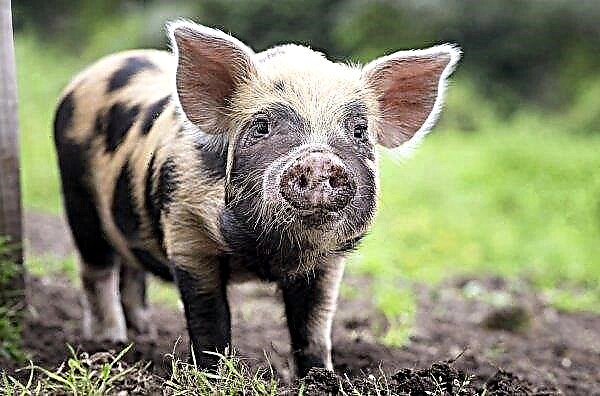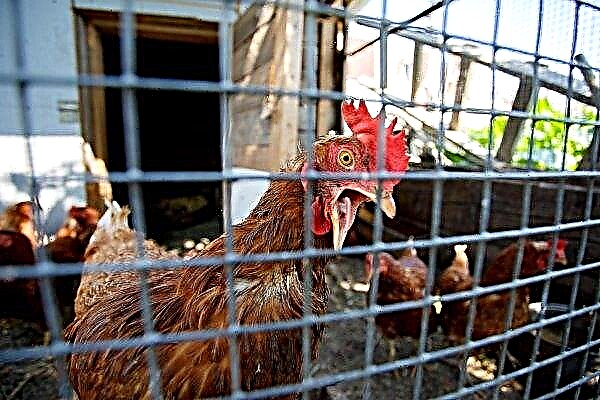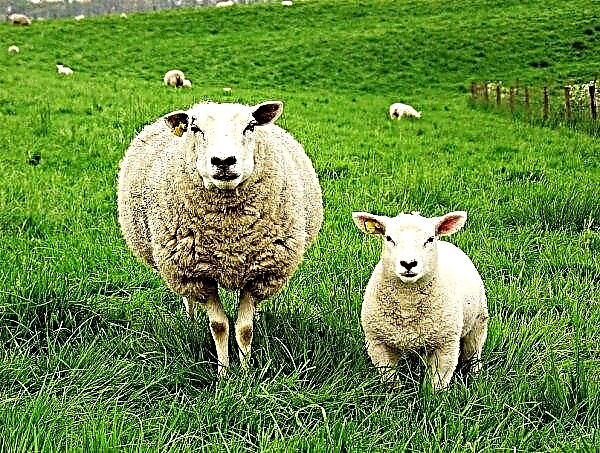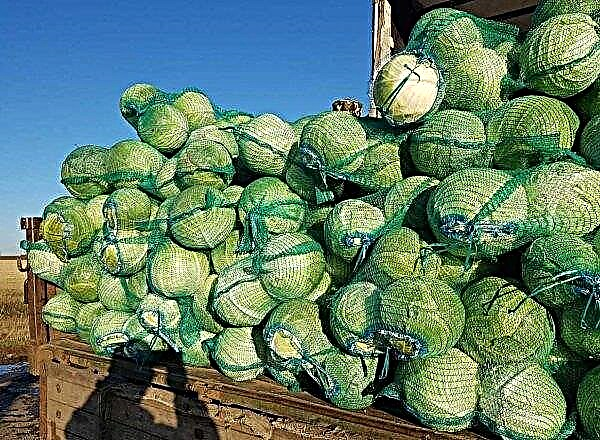The large size and excellent egg production are famous for many breeds of chickens. However, in poultry farming one of them is especially distinguished - sussex, which can rightfully be considered the ancestor of numerous breeding branches. A beautiful exterior, tasty meat, good productivity and fairly easy maintenance made this breed privileged for a huge number of chicken farms.
Historical data
The exact time of occurrence of the Sussex breed cannot be established. Particularly persistent breeders were able to find a mention of these poultry in ancient Roman records dated 43 year BC. e. Probably, the breed arose earlier. Farmers of Sussex county (England) were engaged in active breeding and selection of the breed in Europe - it was thanks to their efforts that the modern exterior of the breed was obtained and its name was fixed.
Did you know? The British were so proud of their success in breeding sussex chickens that they bred a special royal breed, which they solemnly presented at the coronation personally to King George. Its color, white with lilac, has been preserved even now, but the number of birds of the royal breed barely reaches 50 pieces throughout the country.
According to unconfirmed reports, sussex was obtained by breeding a cross between the native chicken stock of the county and individual breeds: cornish, dorking, light brama, orpington, white kokhinhin. Due to the diversity of breeding material, several varieties of sussex have been bred, characterized mainly by the color difference of plumage. In the UK, there is great interest in raising Sussex chickens to such an extent that there is a club of farmers who are still breeding and improving this breed, continuing family farming traditions. The club was formed back in 1903, but there has not yet been a decrease in the activity of its members. The counting of domestic selection of sussex chickens has been going on since 1961, when they were first brought from the UK. On the genetic basis of the "English women" local breeds of May Day and Adler silver were bred, which are very close to their ancestors, but better adapted to local conditions.
The club was formed back in 1903, but there has not yet been a decrease in the activity of its members. The counting of domestic selection of sussex chickens has been going on since 1961, when they were first brought from the UK. On the genetic basis of the "English women" local breeds of May Day and Adler silver were bred, which are very close to their ancestors, but better adapted to local conditions.
Did you know? Sussex chickens of purebred lines are light, regardless of the color of adult individuals, always downy yellow. However, already at the young growth stage, it is possible to determine the sex of future chickens by the color of down: roosters have a light yellow color, and hens have a dark yellow color.
Today, sussex is bred in many areas. The breed is used on farms to improve egg production, and as a maternal basis for growing broilers. For large farms, only the Sussex dominant is suitable due to genetically improved productivity.
General characteristics
These birds have the main light color of feathers almost always, with the exception of a few motley species. In breeding selection, sussex breeders experiment mainly with plumage of the mane and tail, however, the silver gene remains unchanged and “untouchable” attribute of the breed. It is transmitted from the hen only to rooster chickens.
Appearance
The appearance of Sussex is characterized by a variety of color plumage of plumage, as well as a contrasting combination of feathers of the mane and tail with the main color. In most cases, it is precisely by these decorative characteristics that the breed can be easily distinguished from the general population, since the birds look bright and festive.
Important! Egg production of chickens in the winter decreases, but does not stop completely.
Sussex appearance features:
| Head | It is small, wide; eye color - red or orange, small specks are allowed; rounded and smooth earrings have a red color; red lobes adjoin the head quite tightly, but poorly developed |
| Crest | erect, rough, 4–5 clearly marked teeth |
| Beak | light pink, with apex slightly darker |
| Neck | moderate length; in most breeds it has abundant plumage contrasting with the main color |
| Chest | wide, with an arched profile, smoothly turning into the horizontal plane of the body |
| Stomach | soft, rounded |
| Wings | with a high fit, snug fit, overall length medium |
| Tail | moderate in length, slightly raised upward, widens at the base, has a lavish integumentary plumage, especially in males |
| Paws | light, strong, with well-developed muscles, on the metatarsus there may be stripes of a reddish hue, 4 even fingers |
| Plumage and color | plumage uniform in density, soft; the color can be porcelain or chintz, silver, white, motley, Colombian (the main color of the feathers is white, and the “collar” on the neck and tail have a contrasting black color), yellow-Colombian (the main color is yellow, but the tail and “collar” are black ), lavender or pale lilac |
Temperament
Hens and roosters of Sussex have a fairly calm character. The bird gets along well with the neighbors in the house, is friendly with people, quickly gets used to the owner and trusts him completely, in some cases it can even become tame. Excellent hens and caring mothers for chickens grow from hens. Incubation of egg laying is not required. At the same time, they equally well take care of their offspring and of someone else's, if, for example, they put turkey or goslings on them to incubate.
Excellent hens and caring mothers for chickens grow from hens. Incubation of egg laying is not required. At the same time, they equally well take care of their offspring and of someone else's, if, for example, they put turkey or goslings on them to incubate.
Did you know? Sussex hens are able to sit and grow 2–3 brood out of 13–15 chickens per summer.
Advantages and disadvantages
- pros
- excellent immunity and high survival rate of young animals (98%);
- balanced non-aggressive character;
- unpretentiousness in feed;
- quick adaptation to the owner, premises and conditions of detention;
- excellent resistance to diseases that are typical of poultry;
- favorable genetic material for selection and breeding of hybrid individuals, the sex of which is available to determine on the 2nd day after birth.
- Minuses
- difficulty or inability to buy purebred sussex for growing, although the cost of adults cannot be called high;
- excessive "talkativeness" of birds can cause dissatisfaction of neighbors;
- lack of free space for the construction of a spacious chicken coop or the organization of a site for walking birds.

Features of keeping at home
The maintenance of sussex chickens does not require rich experience and in-depth knowledge from the farmer. This bird can be successfully grown even by beginners. Natural survival of young animals is good, the bird does not need ideal conditions, as well as special privileges in nutrition, but it still requires some care.
Chicken coop
Find out also

Successfully practiced outdoor sussex content method. The floor is lined with a deep non-replaceable litter. It is important to pay attention to the organization of lighting in the chicken coop. It should be good, and for very young chickens - around the clock. 2-3 weeks after the birth of the chicks, lighting begins to be systematically reduced to the duration of a normal daylight hours. Dim light can reduce the egg laying of adults. Sussex breed tolerates the cold season and wintering well. The temperature in the room is not necessarily kept high, but in winter the walls should be insulated. Growing newborn chickens is demanding for temperature: 30 ° C is a comfortable temperature for keeping young stock in the first 2 weeks of life. In the chicken coop, pallets or shallow containers are filled without fail, filled with a mixture of ash and sand, so that the bird can clean the feathers of parasites.
Sussex breed tolerates the cold season and wintering well. The temperature in the room is not necessarily kept high, but in winter the walls should be insulated. Growing newborn chickens is demanding for temperature: 30 ° C is a comfortable temperature for keeping young stock in the first 2 weeks of life. In the chicken coop, pallets or shallow containers are filled without fail, filled with a mixture of ash and sand, so that the bird can clean the feathers of parasites.
Walking patio
Sussex farmers are confident that the taste and quality of the meat is affected by the time and quality of the poultry walking. They indicate the need to organize a spacious yard with good lighting for walking chickens at any time of the year, even daily in the winter. In the courtyard, hens should be able to graze, take sand baths from parasites.
It is also recommended to pour a little crushed gravel in some place, if it is not available in natural conditions, so that birds can use it to regulate digestion if necessary.
Feeding troughs and drinking bowls
Feeders and drinking bowls are also required for installation in the house and in the walking yard. Feeding equipment can be bought or designed by yourself, but it is preferable to have special equipment for the house so that food and water are not sprayed around. Sussex chickens are neat in egg laying, but when feeding they behave untidily, like any poultry. At the same time, they will not eat food that has been trampled on, has a stale smell, musty, etc., therefore it is advisable to install a bunker type in the chicken coop and on the platform for walking the feeder. They can be purchased at the store or built independently. It is not recommended to use open dishes as drinking bowls, because birds are very likely to tip the tank or pollute the water extremely quickly. It is more practical to install closed drinking bowls (siphon, vacuum) or with automatic water supply (nipple) in the chicken coop. Nipple drinkers are a priority for choice because of their economy, high hygienic qualities and suitability of use for both adult chickens and chickens.
They can be purchased at the store or built independently. It is not recommended to use open dishes as drinking bowls, because birds are very likely to tip the tank or pollute the water extremely quickly. It is more practical to install closed drinking bowls (siphon, vacuum) or with automatic water supply (nipple) in the chicken coop. Nipple drinkers are a priority for choice because of their economy, high hygienic qualities and suitability of use for both adult chickens and chickens.
As mentioned above, the Sussex breed is unpretentious and hardy, but proper care and feeding are necessary and necessary to obtain the desired productivity. The use of equipment for feeding can significantly save the fodder issued to the bird, reduce the cost of their maintenance and allocate funds for the purchase of high-quality balanced compound feed. Water in drinking bowls needs to be changed regularly, as well as to monitor the availability and quality of feed in the feeders.
Herd replacement planned
Sussex chickens are distinguished by an excellent immune system, so they can live up to 10 years (Sussex dominant), while maintaining egg production. Planned replacement of the herd is carried out with a decrease in egg production or to improve the pedigree of the livestock. Since this breed is universal, the farmer decides what he needs - meat or eggs. To grow poultry for meat, you can bring chickens to 1.5 kilograms in 70 days. These chickens are quickly fattened to obtain meat mass and always show excellent growth. By egg laying, only the first year is always the most productive. In the future, the indicators will only decrease, but the rate of decline is very slow and practically differs by only a few eggs per year.
These chickens are quickly fattened to obtain meat mass and always show excellent growth. By egg laying, only the first year is always the most productive. In the future, the indicators will only decrease, but the rate of decline is very slow and practically differs by only a few eggs per year.
Seasonal molt
Shedding for Sussex is a real stress, which they are experiencing hard, so they require a special attitude to themselves during this period. Egg production during shedding decreases, vitality decreases, and any negative effects immediately lead to dangerous consequences for birds. Therefore, when molting, it is recommended to additionally enrich the feed with a complex of vitamins and minerals.
What to feed
Sussex breed feeds well on pasture. Chickens are able to find their own food on their own, but for the normal growth and vital activity of natural fodder, of course, there will be little. “Wild” food has a positive effect on the taste of meat, but it is necessarily complemented by a basic diet. The adult bird Sussex and young animals are not picky in food, therefore, difficulties with their content should not arise. At the same time, there are some differences in the feeding of adults and chickens.
Adult Chicken Menu
When breeding sussex chickens, farmers do not have problems with poultry nutrition if they use special ready-made compound feed. It is it that is recommended as the basis for the daily diet of adult birds due to the balanced composition of nutrients for growth and development. If there is no opportunity to purchase ready-made food, you need to develop a separate bird menu based on grain crops (wheat, corn, oats, barley).
From time to time, the base is supplemented with necessary additives so that the birds develop correctly and receive a sufficient amount of minerals. It is especially important for laying hens to consume calcium when laying eggs, so the bird should be given chalk, crushed eggshells, shells, or to pour meat and bone meal.
Important! The diet of laying hens should be controlled: the more their mass, the less eggs they carry.
To ensure the proper functioning of the digestive system, adult Sussex individuals must have access to sand or fine gravel.
Chicken Diet
Sussex chickens in the first days after birth are fed with grated egg and grain. Then they are gradually transferred to compound feed, which is designed specifically for young animals. If the farmer does not have the opportunity to buy specialized ready-made food for chickens, you must independently develop a complete diet. Variety in the menu of growing individuals should be introduced gradually:
Variety in the menu of growing individuals should be introduced gradually:
- millet;
- cottage cheese;
- green food;
- boiled vegetables (carrots, beets, potatoes);
- yeast;
- food waste;
- semolina.
Addiction to disease
The efforts of breeders aimed at the productivity and external data of sussex also affected the resistance of the breed to the main diseases of poultry. In most cases, sussex are immune to pathogens, as birds have a strong immune system, but timely vaccination is recommended for prevention. Sussex chickens can tolerate temperature extremes, but the appearance of parasites on their body can be detrimental to birds. Therefore, in the place of walking and in the chicken coop, it is worth organizing dry baths with sand or ash, conduct regular sanitation measures against parasites and monitor compliance with cleanliness.
Sussex chickens can tolerate temperature extremes, but the appearance of parasites on their body can be detrimental to birds. Therefore, in the place of walking and in the chicken coop, it is worth organizing dry baths with sand or ash, conduct regular sanitation measures against parasites and monitor compliance with cleanliness.
Sussex chickens are economically viable for small farms and farmsteads. The high immunity of the bird and the good survival rate of young animals allow even inexperienced farmers to achieve high productive indicators.












